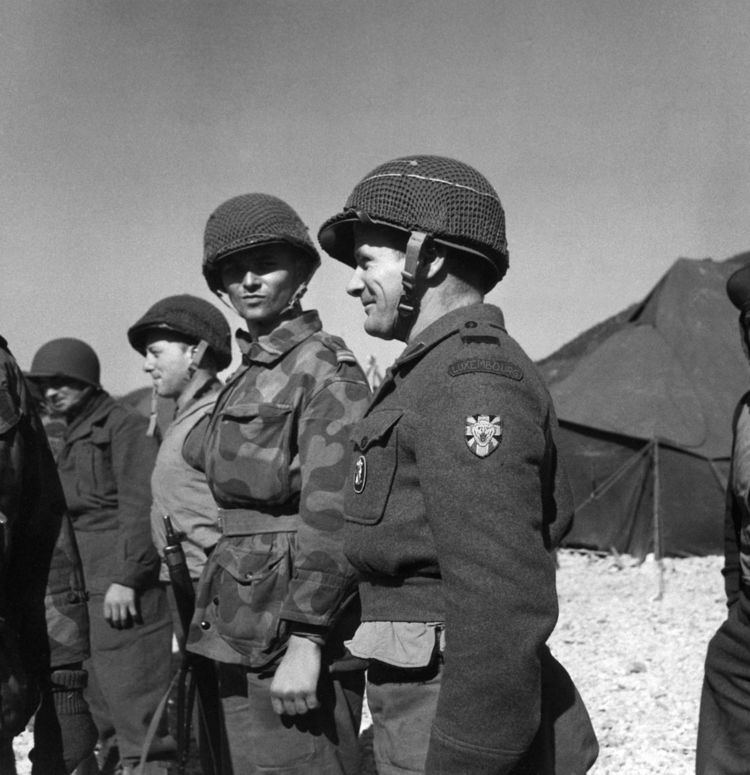Active 1950–1955 Branch Army | Allegiance United Nations Type Infantry Battalion | |
 | ||
Country Belgium
Luxembourg
Republic of Korea Size 3,171 Belgians and
78 Luxembourgers
(over duration of war) | ||
The Belgian United Nations Command (B.U.N.C.), also known as the Belgian Volunteer Corps for Korea or "Brown Berets", is the name given to the Belgian-Luxembourgish military force sent to South Korea to fight in the Korean War by the Belgian government of Joseph Pholien. The battalion served in Korea between 1951 and August 1955, staying in Korea even after the signing of the armistice.
Contents
- Background
- Training
- At the front
- Belgians Can Do Too
- Casualties
- Battle honours
- Commemoration
- Museums
- Monuments
- Notable personnel
- References
By the end of this period, 3,171 Belgians and 78 Luxembourgers had served tours of duty in Korea.
Background
When the Korean War broke out in 1950, Belgium was experiencing a period of turmoil. Belgium had been occupied by the Nazis during the Second World War between 1940–4 and reconstruction was still very much in progress. Politically, the country was torn over the issue of the so-called Royal Question. With the centrist parties thus occupied, both Communist and right-wing Flemish nationalist parties enjoyed considerable support. The Prime Minister in office, when the UN declaration calling for soldiers to be sent to the aid of Korea was sent, was Joseph Pholien of the Christian Social Party who was politically opposed to the rise of communism abroad and wished to gain support from the United States. Both the Belgian and Luxembourgish governments decided to comply with the UN request to send troops to assist South Korea.
Training
Over 2000 Belgians volunteered for service in B.U.N.C. Of these, initially only 700 were selected for training at Leopoldsburg. After training, volunteers received their characteristic brown berets. Soldiers from Luxembourg who were trained alongside the Belgians were organised into 1st Platoon, A Company of B.U.N.C.
The Belgian-Luxembourg Corps sailed from Antwerp to Pusan and arrived on 31 January 1951. On arrival in Korea, some South Korean troops were made part of the Belgian contingent in order to bring the regiment up to correct battalion strength along the lines of the US "KATUSA" or Commonwealth "KATCOM" programme.
At the front
In April 1951, the Belgians fought in one of the key battles of the Korean War – the Battle of the Imjin River. In August, the First Battalion was relieved by a new battalion fresh from Belgium in August 1951 which stayed until 1955.
At the Battle of the Imjin River in 1951, the Belgian battalion held a key pass alongside the British Gloucestershire Regiment. For actions at the Imjin, the Belgians received a US Presidential Citation. During the battle, Albert Crahay, commander of the unit, was wounded by a Chinese phosphorus shell and was evacuated to a hospital in Japan.
B.U.N.C. continued to see action and went on to earn further battle honours at Haktang-Ni – one of the series of battles at Broken Arrow – in October 1951 when the Belgians took up position on an isolated hillside and suffered relentless Chinese attacks which they successfully repelled, killing over a hundred Chinese and losing only a handful of men themselves.
The last main action fought by the Belgian contingent was at the Battle of Chatkol in April 1953. Belgian forces held a defensive arc position in the Iron Triangle for over 55 nights of Chinese assaults.
After the cease-fire, it was seen as unnecessary to keep BUNC up to the strength it had during the war and it was reduced to some 200 men on 30 December 1954, but, like other UN contingents, it was viewed as necessary to maintain a presence in Korea during the uncertain peace following the negotiations at Panmunjon and the last members of the unit finally left Korea on 15 June 1955.
"Belgians Can Do Too!"
BELGIANS CAN DO TOO! was a slogan written across the windshield of Padre of the Unit's (Padre Vander Goten) Jeep during the battles around the "Iron Triangle." Seeing the exhaustion of the troops, the Padre copied the motto of the US 15th Infantry Regiment ("Can Do") alongside whom the Belgians were serving at the time to try to raise morale. The phrase was made famous in Belgium and is thought to summarise the spirit and courage of the Belgian contingent.
Casualties
101 Belgian soldiers, 2 Luxembourgish soldiers and 9 South Korean soldiers attached to the Belgian contingent were killed during the war. 478 Belgians and 17 Luxembourgers were wounded in action and 5 Belgians are still posted as missing. 2 died in North Korean POW Camps.
Battle honours
B.U.N.C. was awarded two South Korean Presidential Unit Citations and one American Unit Citation.
The text of the US Presidential Unit Citation for actions at the Imjin River:
The Belgian-Luxembourg Corps served at three key battles of the Korean War – the Battle of the Imjin River 1951, the Battle of Haktang-ni and the Battle of Chatkol 1953.
Commemoration
The 3rd Parachute Battalion maintains the traditions (including the flag and badge) of BUNC and is based in Tielen.
